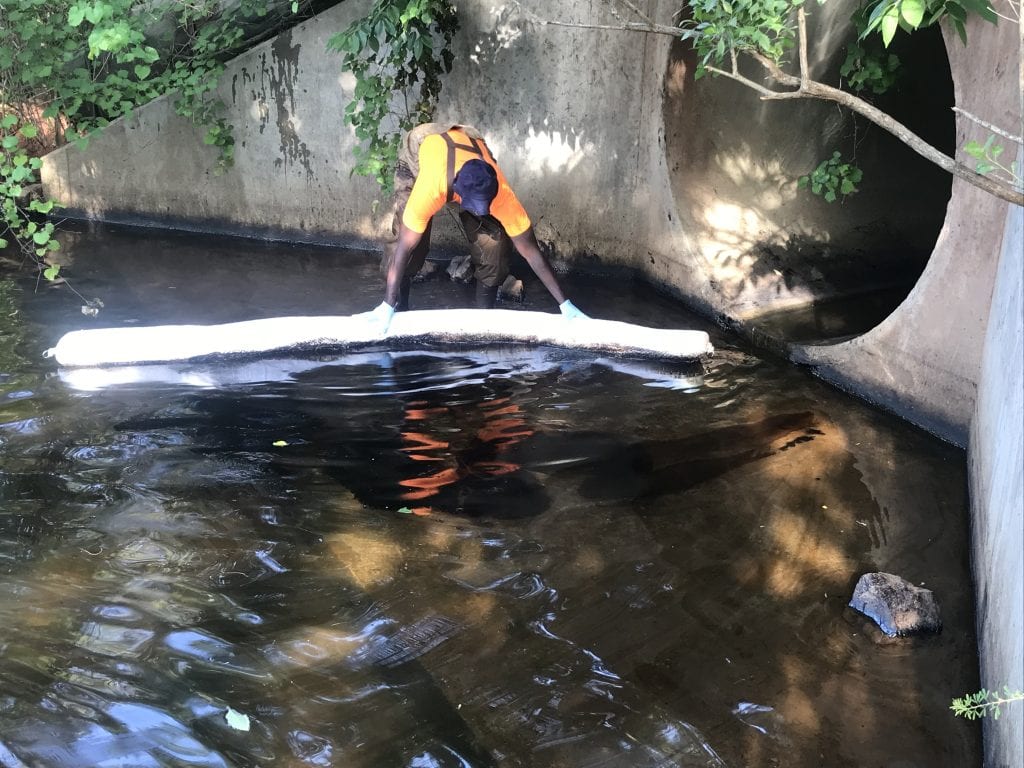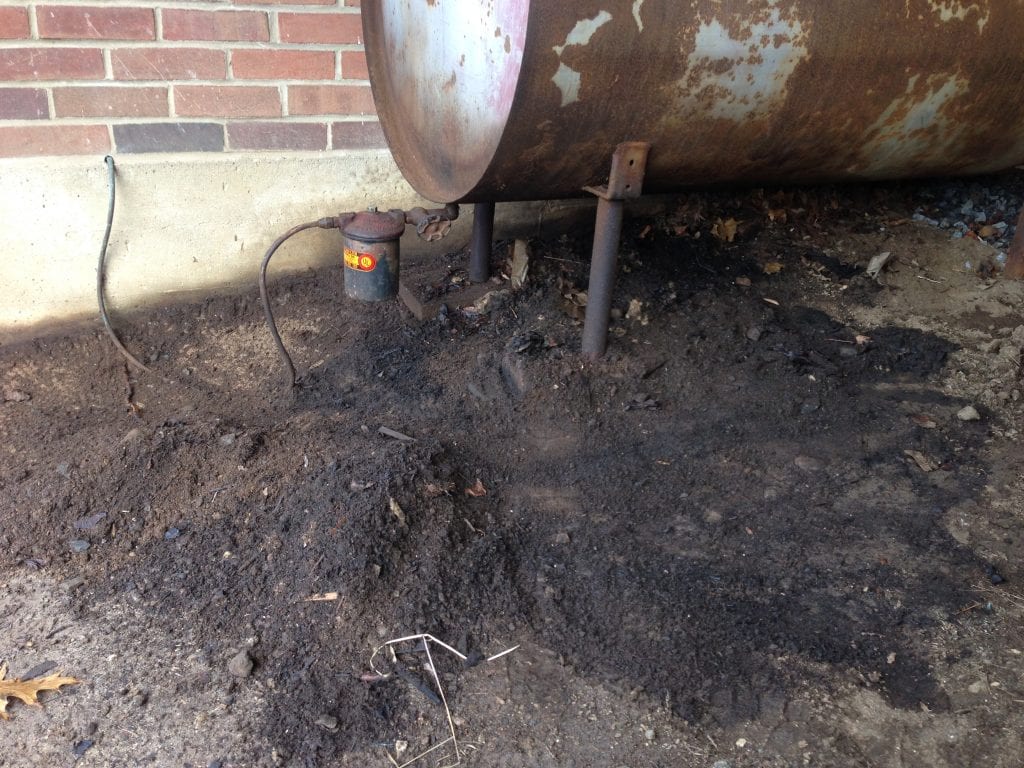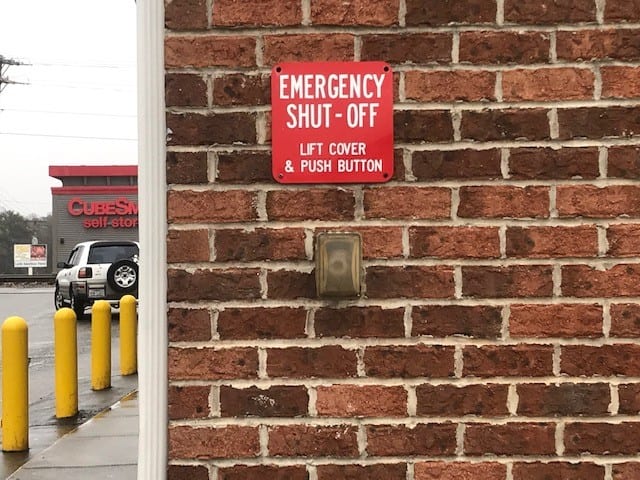
When I get a call about what a customer should do about an oil or gasoline spill my first impulse is to say “it depends.” Then I ask: How much spilled and where did the spill occur? Let’s break the question down by spills that commonly occur at three types of locations.
- residential properties
- gasoline stations
- industrial facilities
Before I talk about what to do, the initial focus for any spill is always scene safety. Petroleum products may generate explosive vapors, hazardous fumes and oxygen deficient environments. Do not go rushing into a potentially hazardous situation until risks are identified and mitigated.
Ensuring scene safety may include activating shutoff switches, eliminating ignition sources, opening windows and doors, ventilating the area, conducting explosive atmosphere testing and restricting access. If you are not prepared to safely handle the situation, dial 911 and let the professionals make sure the scene is safe!
Spills at Residential Properties
The two most common spill scenarios at residential properties are leaks from portable gasoline containers (e.g., for lawn equipment) and leaks from heating oil systems.
Small container upsets
Small container leaks and fueling overflows are usually pretty benign. The key is to soak up the spill quickly. Use dirt, sand, cat litter or professional grade oil sorbent materials. Do not put water on liquid gasoline, it will just spread it around! Never wash spilled oil or gasoline into a drain! Washing gasoline into a storm drain can turn a relatively minor spill into a much more difficult cleanup and potentially hazardous situation.
Fuel oil spills

Leaks from basement fuel oil tanks, outdoor above and below grade fuel oil tanks and associated fuel distribution lines can be disruptive and even disastrous. If the leak is caused by a small drip, place a pan under it to prevent the spill from spreading and call a service technician. Concrete is porous so standing fuel can seep into cracks and into the concrete itself and cause long term odor issues.
If the spill is catastrophic and in an enclosed basement, call 911 and then call your supplier. If the spill was the result of a fueling error, the supplier may take responsibility for the cleanup. Also call your insurance company. Large spills (more than 2-3 gallons) require professional intervention and may render the dwelling uninhabitable. Expect an initial abatement and then an investigation into the extent of residual contamination. Impacted subsurface soil and groundwater may require substantial demolition and remediation efforts.
Professional tip
If you have a leak in your basement and your storage tank is taken out of service, make sure the fill port is secured. I can’t tell you how many times I have seen an extra 275+ gallons of fuel pumped into a basement because the tank repair technician did not communicate with the fuel delivery operator!
Spills at Gasoline Stations
Spills at gas stations can range from customer or delivery fueling errors to major system component failures.
Fueling Errors

All gas stations are required to have easily accessible emergency shut-off switches. Fuel system shutoff is typically activated by a large button on a wall. Fuel dispensers also have shear valves that close if a hose is pulled off or if a dispenser is knocked off its base. Yes, customers have been known to drive away with the nozzle still in their gas tanks and to run into dispensers! Shear valves usually work in these circumstances, but not always.
Small surface spills should be treated with speedy dry or other sorbent materials. If a surface spill is extensive, sorbent materials or dams should be used to block off downgradient storm drains. Large surface spills require the assistance of an emergency response contractor. If there is a fire associated with the spill, dial 911.
All spill volumes above state mandated reporting limits must be called in to the corresponding state Spill Hotline. Localities may have additional reporting requirements. The corresponding environmental agencies will follow up with verbal and written instructions for documentation and requirements for further investigation if necessary. If spills are transmitted via storm drain to navigable water ways there may be additional reporting requirements.
UST System Component Failure
Leaks from underground storage tank systems range from slow leaks over time to catastrophic failures. Common leak discovery methods include inventory discrepancies, leak detector notifications, subsurface utility impacts, soil contamination and groundwater impairment. These types of impacts all trigger a mandatory call to the state spill hotline. Environmental regulatory agencies will outline subsequent site investigation and possible remediation requirements.
Certification requirements dictate that the owner/operator retain the services of a qualified professional to conduct the investigation, make repairs and deliver the corresponding reports to the appropriate regulatory agencies. Restoration of contaminated soil and groundwater may be time consuming and expensive.
Spills at Industrial Facilities
If a business facility stores oil or oil products with a total above-ground storage capacity greater than 1,320 gallons, in containers that are larger than 55 gallons, they must have a Spill Prevention, Control, and Countermeasure (SPCC) Plan. A business also is required to have an SPCC Plan if they store more than 42,000 gallons in an underground storage tank that is completely buried.
The SPCC Plan outlines how to respond to a spill, who to notify and what reports must be submitted.
SPCC Plans are typically organized to contain the following elements:
- Contact Information for Responsible Parties
- Project and Site Information
- Potential Spill Sources
- Pre-Existing Contamination
- Spill Prevention and Response Training
- Spill Prevention
- Best Management Practices used to prevent discharges to ground or water during mixing and transfers
- Fueling and Filling Procedures
- Daily inspection and cleanup procedures
- Routine equipment, storage area, and structure inspection and maintenance practices
- Site inspection procedures and frequency
- Project Site Map
- Spill Report Form
- Sequence of Information
A complete SPCC Plan that conforms to environmental regulations may range from 15 to 100 pages depending upon the size and storage capacity of the facility.
A common mistake made by growing businesses is they might not realize they have reached the oil products storage threshold for the SPCC requirement. Another common error made by growing businesses is the SPCC rule is based upon storage capacity not amount of oil stored. If a business has a 500-gallon container that is only half-full, the EPA still considers it full of 500 gallons of product. Oil products include diesel fuel, gasoline, lube oil, hydraulic oil, vegetable oil, bio fuel, heating oil, etc.
Key takeaways
Spill cleanup can be complex, dangerous, and expensive. If you do not know what you are doing, call a professional.
If you have a facility that stores oil, periodically review applicable environmental compliance regulations and update your response plans.
A spill emergency is not the time to figure out whether you should call the National Response Center, the US Coast Guard, the state Spill Hotline or a myriad of other government agencies. It is also not the time to start googling emergency response contractors. If you utilize oil products, prepare ahead of time.
About the author:
Allan Blanchard is the President of Ambipar Response EMS, Inc. He directs a team of professionals working on environmental and sustainability projects throughout the eastern US. Allan has over 30 years of experience in the assessment and remediation of sites contaminated by hazardous materials and petroleum products.

